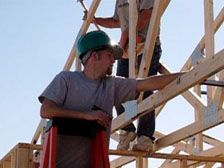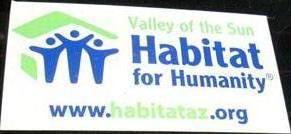|
|
Habitat
for Humanity
When we think of master planned communities, we think of upscale, in
many cases gated, housing communities occupied by upper and upper
middle class families. As more and more of these communities are being
built around the country, the opposition to master planned communities
and their home owners associations (HOAs) is also increasing at the
same time. Many feel that master planned communities, especially gated
ones, amount not only to physical, structural segregation but
segregation by income and race as well.
In his article, "When Extreme Political Ideas Move into the
Mainstream", geographer Andrew Kirby points out an anti-master planned
community/HOA organization that compares master planned communities and
HOA to Nazism, Fascism, and Communism saying that: “master planned
communities and everyone and everything that supports them is the
greatest threat this nation has faced since its birth” (Kirby, 217). I wouldn't go as far as to call HOAs and master planned communities
Fascist. However, the members of this anti-HOA organization do make a
good point in regards to segregation of classes and what our cities are
going to look like in the future.
I wouldn't go as far as to call HOAs and master planned communities
Fascist. However, the members of this anti-HOA organization do make a
good point in regards to segregation of classes and what our cities are
going to look like in the future.
Phoenix is one of the largest cities in the country and growing. The
number of communities for wealthier Americans, surrounded by tall walls
and gates is increasing, and at the same time there is a lack of
affordable housing in metropolitan Phoenix.
We now
turn our attention to a different type of master planned communities,
ones built by the Habitat for Humanity. Two of the only master planned
HfH communities, South Ranch and Villas Esperanzas (Village of Hope)
are located in heart of South Phoenix. What makes Habitat for Humanity
so unique and different is the main purpose of this non-profit
organization, and that is to eliminate poverty housing and build
affordable homes for hard working low-income families. What
distinguishes HfH communities from other master planned communities is
that they are inclusive rather than exclusive. What I mean by this is
that the homes are affordable so some families are not excluded because
of their lower income. Since its formation in 1967, HfH, has built more
than 175,000 houses worldwide, housing more than 750,000 people. 
I am glad that I took the opportunity to participate as a
volunteer in building an affordable house in Villas Esperanzas
community. Along with two classmates, I was hammering in the trusties
spacers. At the end of the day I felt great that I was involved in a
Habitat home construction. Habitat for Humanity is mostly based on
sponsorship and volunteer work. Volunteer opportunities are available
in number of fields including construction, fundraising, family and
office services. HfH also accepts monetary as well as land donations.
It is unfortunate that there aren’t more of similar kind of
organizations.
|

 I wouldn't go as far as to call HOAs and master planned communities
Fascist. However, the members of this anti-HOA organization do make a
good point in regards to segregation of classes and what our cities are
going to look like in the future.
I wouldn't go as far as to call HOAs and master planned communities
Fascist. However, the members of this anti-HOA organization do make a
good point in regards to segregation of classes and what our cities are
going to look like in the future. 